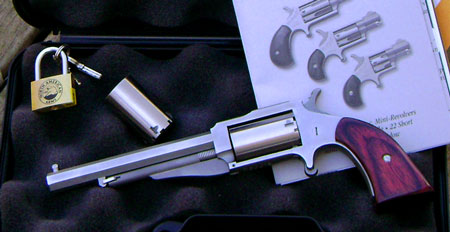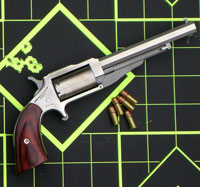
My regular readers (both of them) know that I have a deep, abiding affection for the mini-revolvers of North American Arms (NAA). I really like the North American Arms Earl.
I don’t hold with the assumption that the only reason for a gun’s existence is self-defense. If that were true, we’d have no use for more than half the guns on today’s market. There’s plenty of room in the shooting sports for fun guns, those used for pure recreation. And if you, like I, appreciate the pure pleasure of just plain shooting, NAA has a real winner for you: The Earl.

The Earl is the most imaginative take on the mini-gun concept ever offered. The brainchild of the late Earl Hubbard, an NAA assembly technician, and his son Dustin, The Earl is a slender, stylish .22 that bears more than a passing resemblance to a shrunk-down 1858-pattern Remington percussion revolver.
Actually, it looks to me more like a half-scale, stretched-out Remington New Model Pocket .31 cartridge conversion, but that’s splitting hairs.
The beauty of The Earl lies not in its historical accuracy, but in the fact that it occurred to the imaginative Mr. Hubbard in the first place how striking the basic NAA .22 revolver would look if you put a faux loading lever, four-inch octagonal barrel and square-butt grips on it.
The Earl incorporates many of the features found on revolvers of the mid- to late-Victorian period: spur trigger, pinched barleycorn front sight and milled groove rear sight. Unlike all those Otis Smiths, Hopkins and Allens and Remington Smoots, however, The Earl is constructed of low-lustre 17-4 pH stainless steel, a material that’s preferred by the aerospace industry for its toughness and durability.
Mini-gun fanciers may remember something similar offered back in the 1980’s, the Freedom Arms Boot Gun. Designed by Dick Casull, the Boot Gun was a nifty .22 four-shooter with a three-inch round pipestem barrel.
Unlike the discontinued Boot Gun, however, The Earl has an unfluted five-shot cylinder; safety notches between the chambers; a somewhat heavier, longer octagonal barrel; a heavier frame; and a loading lever that serves as a cylinder pin lock. (Yes, I know it’s not a loading lever in the cap-and-ball sense, but that’s what I’ll call it.) Now highly regarded as a collectible, the Freedom Arms Boot Gun was a total hoot to shoot. So’s The Earl.
My prototype sample of The Earl is a convertible model with separate cylinders for .22 LR and .22 WRM, aka .22 Magnum. (According to Sandy Chisholm, NAA’s affable and erudite CEO, a single-cylinder version chambered for .22 WMR will also be available.) Its manual of arms is a bit different from that of NAA’s other minis. To load, put the gun on half-cock, pull back on the loading lever lock, and pivot the lever downward.

Roll the cylinder out of the frame and fill it up with your favorite ammo du jour. Roll the cylinder back into the frame, making sure that bolt protruding upward from the bottom shelf of the frame recess catches one of the bolt notches on the cylinder. Align the cylinder and insert the cylinder pin. Then flip the loading lever back into position, making sure it locks into place.
To put the gun “on safe” (i.e., with the hammer resting in a safety notch), pull the hammer back just far enough that the cylinder bolt retracts and the cylinder rotates freely. Look down through the firing pin recess in the topstrap and rotate the cylinder so that a safety notch – NOT the brass rim of a live cartridge – is visible through the firing pin recess in the topstrap. Then, holding the hammer firmly under your thumb, squeeze the trigger. Carefully lower the hammer all the way into the safety notch and release the trigger. This may sound complicated but it’s not, really. Do it a few times and you’ll be a pro.
To shoot, cock the hammer – like all .22 mini-guns, The Earl is single-action-only – and squeeze the trigger. To extract empty brass, put the gun on half-cock, retract the loading lever, remove the cylinder pin, roll out the cylinder, and use the pin to poke out the empties.
My sample The Earl – it sounds weird to write it like that, but that’s its name: “The Earl” – had a rather stiff trigger pull that caused me to pull left with every shot. Part of this heavy trigger is undoubtedly due to the scant leverage afforded by that tiny spur trigger, so I’ll have to adjust my firing technique or apply a little Kentucky windage. That, or have a gunsmith do a little stoning job. However, even with its trigger pull, The Earl was commendably accurate at 15 yards off a rest. With high speed .22 Short ammo, my first five-shot group was a tad left of center and measured just over an inch in diameter.
Credit for The Earl must go not only to Earl and Justin Hubbard but to Ken Friel, NAA’s production manager, and all of NAA’s workers way out there in Provo, Utah. Every NAA mini I’ve ever owned has been tight as a drum, giving off all those metallic clicking and snicking sounds that characterize a well-fitted pistol.
Call me a nut, but I use .22 Shorts for most of my mini-gun shooting. I have a long-standing preference for the Short, one I acquired over many boyhood years spent shooting a Remington Model 514 single-shot rifle. Back then, Shorts were cheaper than any other .22 ammo, and even today the sight of a flat little box of Shorts does my heart good. The Earl convertible model will handle an amazing array of .22 rimfire ammo, but Shorts and CB caps suit me just fine most of the time. Hey – we’re talking plinking here!

Personally, I have little use for the .22 WMR in a mini-gun, with the possible exception of the .22 WMR shotshell. Those little numbers throw a pest-killing pattern at 10 to 15 feet, and I once dropped a mouse with one at close to 30 feet.
NAA isn’t marketing The Earl as a hunting gun, of course, or even as a last-ditch defense gun. In the words of Sandy Chisholm, The Earl “might become your favorite plinker,” which to me is a definite possibility. Suggested retail for the convertible model is $324, and the Magnum-only version will set you back $289. For your money, you get not only The Earl but a case, lock and a really neat scaled-down leather flap holster similar to those designed for the original full-size 1858 Remington. (This gives me an idea, one that will almost certainly never comes to pass: offer The Earl in a blackpowder version similar to the NAA Companion.)
So: who will be interested in The Earl? I imagine Cowboy Action shooters will love it, as will anyone whose idea of a good afternoon includes sitting in the sun, shooting at cans. Sandy Chisholm advises that due to NAA’s overwhelming order backlog, The Earl is planned as a limited-production item. If you’re like me, however, it’s certainly worth chasing one down.

Next Step: Get your FREE Printable Target Pack
Enhance your shooting precision with our 62 MOA Targets, perfect for rifles and handguns. Crafted in collaboration with Storm Tactical for accuracy and versatility.
Subscribe to the Gun Digest email newsletter and get your downloadable target pack sent straight to your inbox. Stay updated with the latest firearms info in the industry.








